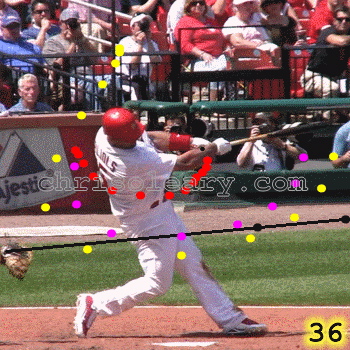I'm skeptical about the claim above.

The pink dot is the sweet spot.
This was a direct quote from the article from GQ. Possibly by reading the article it would make more sense.
When we do this at my house I have two 36 by 74 inch mirrors and there is a string with two golf ball size whiffle balls on it. On the mirrors I have two attachment points and used epoxy to secure it at an angle on the mirrors itself. The bat has two colors of electrical tape to show the sweet spot on the bat as a visual. Home plate is under the string and as they swing slowly the can see them self in the mirrors and see what their bat angle position is and how it changes as they progress, how the shoulders are moving and where the bat head is or is not based on what they are doing. When the end of the bat gets in the zone we think if you can foul it the bat is in the zone and you are still in the game. Now how long it stays perfectly in the zone in our case is not relevant as we are in the first stages of what do you mean by hands inside the ball verses what they have been taught, hands to the ball or throw the bat head at the ball has to be dealt with. Next is when does the bat exit the zone where we could no longer foul the ball and we feel that is important also.
Have you ever compared which MLB player keeps the bat in the big zone longer? From a teaching stand point the kids understand it as we also show chopping down on the ball and swinging level does not keep the bat in the zone as long and lessens our opportunity to hit the ball.
Thanks Howard





